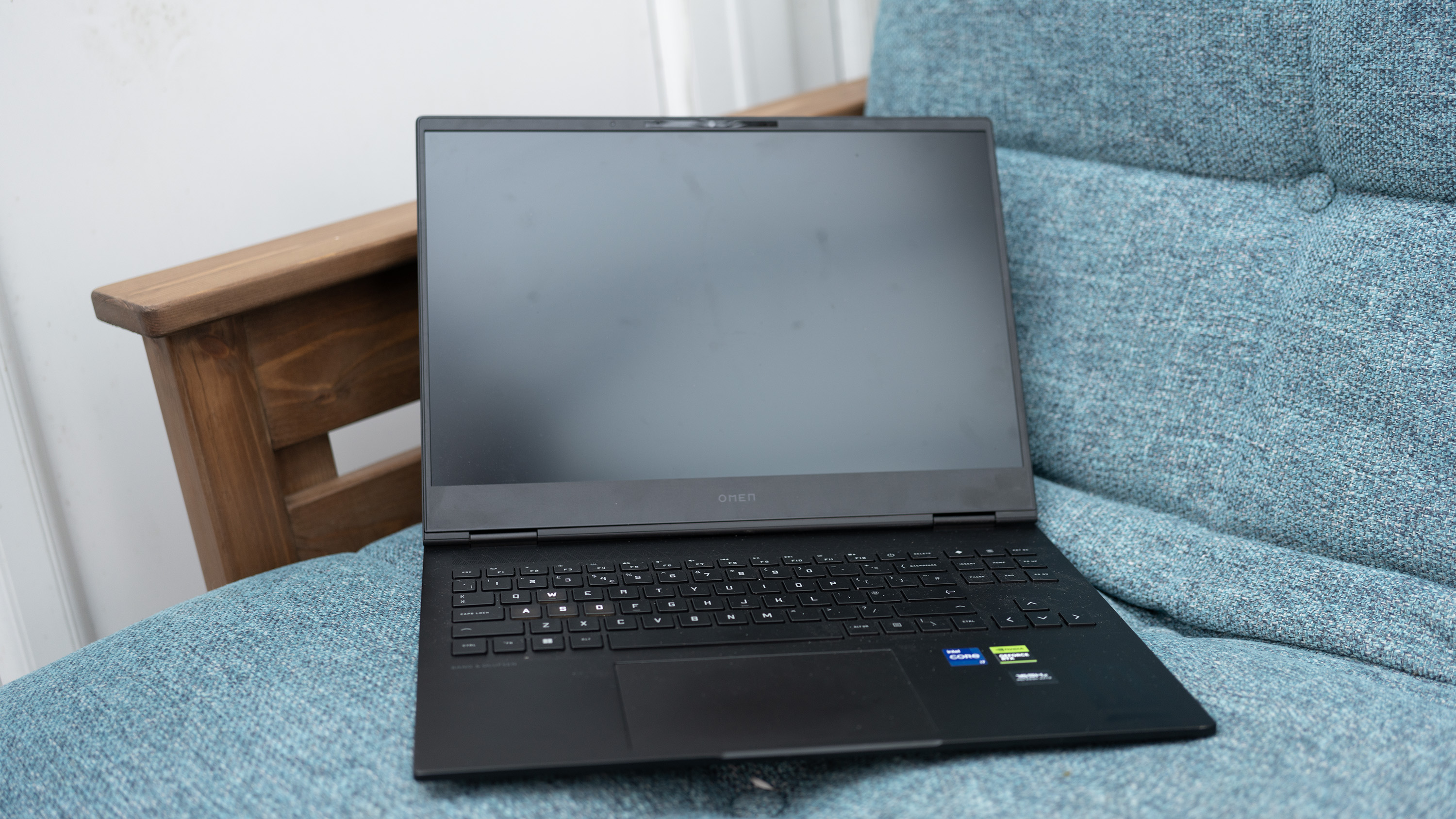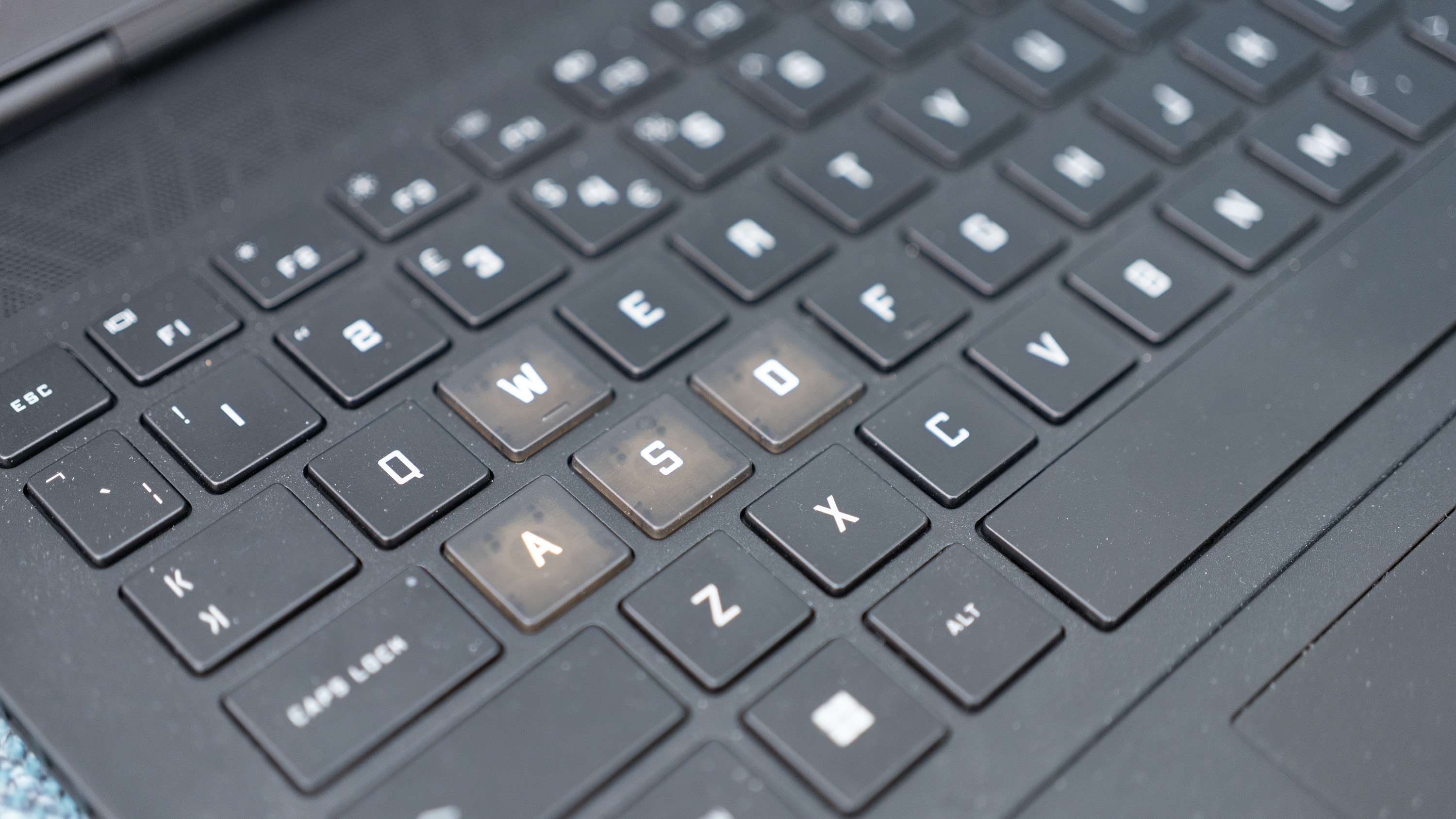
If you’re going to spend nearly £2,000 on a laptop, you’ve got a lot of options. There's Alienware, of course, with Dell’s gaming brand providing a lot of portable power that’s easily repurposed for creative apps. There are entries from MSI and Razer, Acer and ASUS, oh my, and that’s before we get to Apple and Microsoft, who will both liberate many thousands from your wallet if you let them.
However, HP has a good name and reputation in this sector, so its new releases are worth your attention, and the Omen Transcend 16 is the company’s thinnest and lightest gaming laptop yet. Inside, there are some good quality components too, along with a 1TB SSD which is always good to see.

HP Omen Transcend 16: Key specifications
Design, build and display

While some gaming laptops can lean toward the aggressive or gaudy in their styling, HP has opted for restrained black elegance for the Omen Transcend 16. There's no lighting beyond the keyboard and it’s off by default - even the Omen logo on the back of the lid doesn’t light up - unless you install the Omen Light Studio app and start tinkering. Do this, and the keyboard suddenly erupts into rainbow colours from its per-key RGB array that are especially clear on the WASD keys, as these are more transparent than the others. It’s the work of a few clicks to set the backlighting to static white, but you’ll always have those four brighter keys.
A 16-inch laptop chassis makes a great companion to a 16:10 screen, which is what we have here. It’s an IPS, not the mini-LED that some US build-to-order models can be upgraded to, but it doesn’t do a bad job with a rated brightness of 400 nits. The resolution - 1920 x 1200 or WUXGA - is a little low compared to some of the creator laptops we’ve seen recently, but as this is a 165Hz screen driven by a GeForce chip it’s probably expected that users will be more interested in framerates than high resolution. This doesn’t mean it’s off-limits for creative software, as the HDMI 2.1 port on the back allows you to attach an external screen with a more serious number of pixels in it.
HP’s figures claim it can display 100% of the sRGB gamut, and our tests back this up, along with 77% of AdobeRGB and 78% of P3. While the latter two are not quite pro-level figures, they will do for any casual creative work.
The Transcend sits at the ultrabook end of HP’s laptop hierarchy, with the Omen 16 (non-Transcend edition) being thicker and heavier, while the lower-cost Victus machines offer something for more budget-conscious buyers. A top-end laptop like this nets you a magnesium-aluminium chassis with a professional look but a thick bezel at the bottom of the screen, which can look a bit out of place given the thinness elsewhere.
Desktop users will appreciate that the charging, Ethernet and HDMI ports are on the back of the machine, along with a single USB-A, so it can be easily connected up without too many cables snaking across the desk. The Thunderbolt 4 ports are both on the same side, the left, with just a single USB-A on the right.
Keyboard and trackpad

The glowing WASD keys are always going to be noticeable, but could come in handy if you have shortcuts bound to them, or just enjoy a bit of Rainbow Six Seige in your downtime. The keys themselves are a good size, and as no attempt has been made to squeeze a numpad in alongside them, there's room for them to breathe. The arrow keys benefit most from this, as not only are they full-sized, but are easily accessible on the right-hand side of the keyboard without the problem of clipping another key as you reach for Left.
The keys feel good to type on, with a few mm of travel and some firm resistance from the switches. The laptop has some strong sustainability credentials, with HP boasting of recycled ocean plastics and (somehow) agricultural waste that have gone into its construction. There's recycled metal in the keyboard mechanism too.
The trackpad is an HP Imagepad with four-finger gesture support. It’s broad and smooth, with enough of a click that you won’t knock it by accident. There's no fingerprint reader on the Omen Transcend - it uses Windows Hello face recognition via the 1080p webcam instead, and the power button is four keys in from the right side of the keyboard, between F12 and Del, an unusual position that places the dedicated keys for the calculator and Omen Gaming Hub closer to the edge.
Performance

The Raptor Lake Core i7 CPU in the Omen Transcend has 16 cores and is capable of processing 24 threads simultaneously. It’s a step up the processor ladder from the CPU in the MSI Prestige 16 Studio, and this is borne out in its benchmark scores. Its Geekbench scores put it roughly level with the M2 chip in the 15-inch MacBook Air, a more expensive machine once you’ve increased its specs to match the Omen’s. Apple’s laptop may have the edge in slimness and battery life, but these matter most to those who want to use their machine on the move - if it’s pure power you’re after, the Omen is a contender.
Having the extra Nvidia GPU over the CPU’s Intel HD chip gives it a big boost in the graphics department. It may only be an RTX 4060, but if you’re looking for something to accelerate Adobe software or other content creation apps it’s exactly what you need. It gives a significant boost (32%) over the RTX 4050 laptop GPU, which means shorter export times, faster-moving progress bars, and better framerates when you pick up a controller. Our review model came with the Game Ready driver installed, but switching to the Studio driver is a matter of just a few clicks in the GeForce Experience app.
An annoyance came in the form of the Nvidia software used to switch between the GeForce GPU and the Intel HD graphics chip built into the CPU. It has three modes, Auto (the default - does what you’d expect), Optimus (also an auto-switching mode, but different somehow) and Nvidia Only. The last one leads to a lower battery life, but Auto led to constant notifications during benchmarking as it switched back and forth between rendering solutions, each one coming with a chime. It also moved the benchmarking app into and out of windowed mode. Switching it to Optimus mode in GeForce Settings seemed to fix this.
When it’s being made to work hard, the cooling system is clearly audible. Thankfully, the double-fan Omen Tempest cooler produces a soft rushing sound without the whining noise a fan motor can sometimes make. It can be further quietened by using the Omen Gaming Hub app to engage Eco mode, but this will affect performance. There are also Balanced and Performance modes, and we used the former for all testing here.
Connectivity is as fast as you’d expect, with a pair of Thunderbolt 4 ports offering 40Gbps of bandwidth for external SSDs, Wi-Fi 6E giving speedy wireless, and some standard USB 3 Type-A ports for everything else. The 70Wh battery kept the machine running with the screen on for just two and a quarter hours, which doesn’t compare well with other laptops with similar specs though isn’t an uncommon figure for gaming machines. Charging comes via a dedicated brick which is in the box, rather than via a Thunderbolt port, and there's a quick-charge mode that can see it fill up to 50% in 30 minutes.
Price

The UK retail price at the time of writing is £1,799. For £1,800 you can also get some pretty good laptops from other manufacturers, but the Omen is slightly cheaper than many with similar specs. There's the Razer Blade 15 (i7, RTX 4060) at £2,499, or the Alienware x16 (i7, RTX 4070) at £2,099. Creatives will be lured toward the MacBook Air 15-inch (£1,999 with 16GB RAM and 1TB SSD) which will definitely do the job, last longer, and look good while doing it, while Lenovo’s ThinkPad X1 Yoga Gen 8 offers a 2-in-1 experience and i5 CPU, but no GeForce chip, for £2,090. It’s a crowded marketplace, and you’ll get some good performance wherever you look, so you might as well buy on price.
Should I buy the HP Omen Transcend 16?

Laptops that cost just under £2,000 are plentiful, and offer a remarkable degree of performance for portable machines. There is a lot of choice, however, so a PC needs to do something special to stand out. The Omen Transcend manages this by bridging the gap between gaming and professional laptops, its capabilities equally strong in either camp. There may not be any eye-catching headline features like i9 processors or 4090 GPUs on offer here, but the Omen Transcend does just enough right to make itself a likeable machine, despite its thirst for charging.







